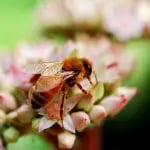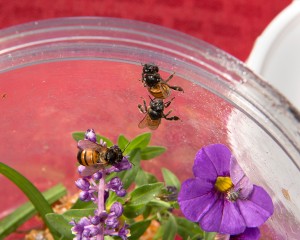How to Tell Bees Apart

When you have a bee infestation, you will first want to find out what kind of bees you have on your hands, as some bees are more dangerous than others and may require more careful methods of removal. Telling bees apart is usually a matter of examining a combination of their coloring, size and behavior, as shown in the following list of common bee species.
- Bumblebees – Bumblebees are twice the size of honeybees, with similar black and yellow stripes (though some species of bumblebee are entirely black). Their long hair, used for collecting pollen from flowers, makes them appear particularly fuzzy. They usually make their homes low to the ground, often under sheds and in abandoned animal habitats such as gopher holes, and will defend their homes aggressively, being able to sting more than once without losing their stinger. They are active only during the warmer months of the year.

Honey Bees
- Honey Bees – Honey bees can be ½ an inch to ¾ of an inch long, and are black and yellow striped. They are drawn to water in dry climates and may make their nests near water, usually in hollow places such as eaves and chimneys. A honeybee will die after stinging once. They are active year-round, but live longer in the winter than they do in the summer.
- Africanized Honey Bees – Africanized honey bees look almost identical to regular honey bees, but are far more aggressive. This invasive species reacts to a wider range of provocation than regular honey bees, including vibration, loud noises, and smells including those of fresh-cut grass, bananas and mammal breath. In addition, they can remain aggressive for multiple days after being provoked.
- Carpenter Bees – Carpenter bees are roughly the same size as bumblebees, with shorter hair and a shinier appearance. Male carpenter bees are black, while females are light brown/tan in color. They tend to fly alone rather than in groups and will bore small holes in wooden materials.
- Stingless Bees – Stingless bees are dark in color, smaller than honey bees and usually found in tropical areas. They build their nests in tree trunks, branches and holes in the ground made by burrowing animals. These bees wouldn’t be much of a problem except that, being unable to sting, they instead bite when provoked.
While there are approximately 20,000 known species of bees, the 5 listed above are the types you are most likely to find on your property. To be absolutely sure of what bee type you have, calling a pest expert such as Green Pest Solutions is probably your best bet. Get $50 your first bee extermination treatment when you mention this blog.